| Skip Navigation Links | ||
 |
 |
 |
AVERAGE ANNUAL WAGE IN ALASKA, 2002 Annual wages in Alaska averaged $37,134 in 2002, an increase of 2.7 percent over the year, according to the Bureau of Labor Statistics of the U.S. Department of Labor. Acting Regional Commissioner Nancy Treadwell noted that Alaska's wage level was slightly higher than the national average ($36,764), but was below that for the Pacific division1 ($40,078). (See table 1.) Alaska ranked 15th highest among all states in wage level and 22nd in rate of increase. Within the 5-state division, annual wages exceeded the national average in California ($41,419), Washington ($38,242), and Alaska. In the two remaining states, pay levels averaged $33,684 in Oregon and $32,671 in Hawaii. (See table 1.) Four of the five states posted wage gains above or close to the nationwide average of 1.5 percent -- Hawaii (4.5 percent), Alaska (2.7 percent), Washington (2.1 percent), and Oregon (1.4 percent). Still, average wages in the Pacific division grew at the slower than average pace of 0.7 percent in 2002, largely due to California's low rate of growth (0.2 percent), fifth slowest in the nation. Hawaii, on the other hand, had the fastest wage growth in the nation. Eleven of the 15 states in the U.S. where the average wage level surpassed the national average fell along the east and west coasts. The five highest wage levels nationwide were in the District of Columbia ($57,914), Connecticut ($46,852), New York ($46,328), New Jersey ($45,182), and Massachusetts ($44,954). (See chart A.) The five states with the lowest annual wages in 2002 - Montana, South Dakota, North Dakota, Mississippi, and Arkansas - have posted the five lowest wage levels every year since 1988. Wages in those states ranged from $26,001 to $28,074. Four-fifths of the 50 states and the District of Columbia had percentage increases in annual wages that exceeded the 1.5-percent growth rate for the nation. Hawaii (4.5 percent), followed by Nebraska (3.8 percent), and the District of Columbia and Rhode Island (3.6 percent each), had the fastest rates of gain in 2002. Eleven other states had percentage increases of 3 percent or more. After a 5-year period without any state or jurisdiction experiencing a decrease in average annual wages, two states, New York (-0.9 percent) and Connecticut (-0.3 percent), reported a decline during 2002. In addition to California, other states with low or no wage growth included Texas (0.6 percent), Colorado (0.1 percent), and Massachusetts (0.0 percent). Annual wage data are compiled from reports submitted by employers subject to State and federal Unemployment Insurance (UI) laws covering 128.2 million full- and part-time workers nationwide. Average annual wage is computed by dividing total annual payrolls of employees covered by UI programs by the average monthly number of these employees. (See Technical Note.) Wage differences among states reflect the varying composition of employment by occupation, industry, and hours of work, as well as other factors. Similarly, over-the-year wage changes may reflect shifts in these characteristics, as well as changes in the level of average wages. 1The Pacific division referenced in this release corresponds to the Census definition and is comprised of five states: Alaska, California, Hawaii, Oregon, and Washington. 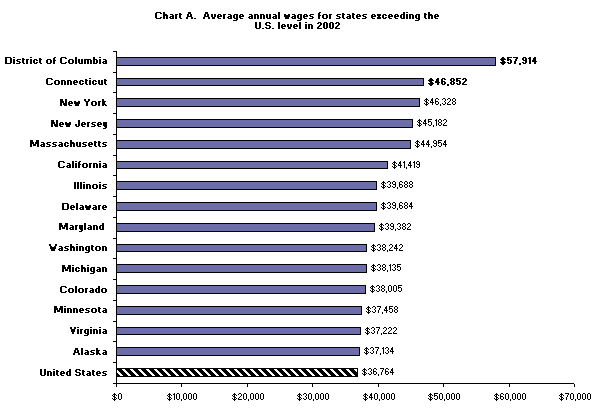 Industry wages Annual wages in Alaska's private sector industries, which comprised 73.8 percent of the work force, increased 2.6 percent in 2002; nationally, wages in the private sector expanded by 1.1 percent. (See table 2.) Private sector wages in Alaska averaged $35,950, fairly close to the national average of $36,539. Retail trade was Alaska's largest industry sector, accounting for 16.0 percent of all private sector employment, followed by health care and social assistance with 12.9 percent. (See chart B.) Mining was the highest-paid industry in the State in 2002, averaging $91,419. Mining workers in Alaska were also the highest paid within the industry nationwide. Arts, entertainment, and recreation was the lowest-paid industry in the State at $14,240. Nine of the 19 private sector industries in Alaska, or roughly half, had higher wage levels than in the United States as a whole. 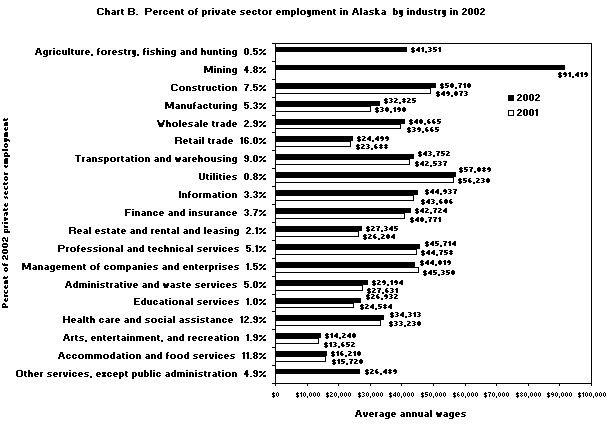
Among all private sector industries in Alaska that had reportable wages in 2001, only management of companies and enterprises reported a decrease in wages in 2002. Changes in wages ranged from a 2.9-percent decline in management of companies and enterprises to a 9.6-percent increase in educational services. Other high wage growth industries were manufacturing, and administrative and waste services, with increases of 8.7 and 5.7 percent, respectively. Within manufacturing, a wage gain of 11.4 percent in the food manufacturing subsector was the driving force behind the overall industry increase in the State. Metropolitan area wages Average wages in Anchorage, Alaska's lone metropolitan area, were $39,112 in 2002; this was above the national average for all metropolitan areas of $38,423. Among the 318 metropolitan areas nationwide, average wages in Anchorage ranked 33rd overall. (See table 3.) From 2001 to 2002 wages in Anchorage increased 2.9 percent, well above the 1.4-percent average recorded for all metropolitan areas. Nationwide, San Jose, Calif., retained its position as the metropolitan area with the highest average annual wages ($63,056), a position it has held since 1997. Still, wages in San Jose were down 4.4 percent over the year--the second-largest decline among the 14 metropolitan areas in the U.S. with decreases in 2002. New York, N.Y., had the second highest wage level ($57,708), followed by San Francisco, Calif. ($56,602); New Haven-Bridgeport-Stamford-Waterbury-Danbury, Conn. ($51,170); and Middlesex-Somerset-Hunterdon, N.J. ($50,457). No other metropolitan area in the country had a wage level greater than $50,000. Wages in these five areas ranged from 31 to 64 percent above the $38,423 average for all metropolitan areas in the nation. Of the 318 metropolitan areas in the United States, only 38 reported levels above the average metropolitan wage. For the 13th straight year, Jacksonville, N.C., had the lowest average annual wage among metropolitan areas ($22,269). The second lowest wage level occurred in Brownsville-Harlingen-San Benito, Tex. ($22,892), followed by McAllen-Edinburg-Mission, Tex. ($23,179), Yuma, Ariz. ($23,429), and Myrtle Beach, S.C. ($24,672). While the order of rankings has differed in prior years, these five metropolitan areas have had the lowest average annual wages since 1996. From 2001 to 2002, 45 metropolitan areas experienced less than average wage growth (1.4 percent). Of these, 13 areas had increases of 1.0 to 1.3 percent, 17 experienced growth of less than 1 percent and one metropolitan area had no change. Fourteen areas recorded declines in average annual wages. Seven metropolitan areas reported declines of 1 percent or less in average annual wages, six areas reported declines of more than 1 percent but less than 5 percent, and one reported a decline of more than 5 percent. Wages in large counties Average wages in Anchorage, Alaska's lone large county, were $39,112 in 2002. Among the 315 large counties nationwide, wages in Anchorage ranked 77th overall. From 2001 to 2002, average wages in Anchorage County rose 2.9 percent; the increase was above the nationwide average of 1.5 percent, ranking 124th in wage growth. (See table 4.) New York County, N.Y., comprised entirely of the borough of Manhattan, retained the top position among the highest-paid large counties with an average annual wage of $72,454. Santa Clara County, Calif., was second averaging $63,056, followed by Fairfield, Conn. with $60,712, San Francisco, Calif. with $58,510, and Suffolk, Mass. with $58,253. There were 201 counties with wage levels below the national average. Cameron County, Texas ($22,892) reported the lowest wage, followed by the counties of Hidalgo, Texas ($23,179), Horry, S.C. ($24,672), Yakima, Wash. ($24,934), and Pasco, Fla. ($25,602). Manatee County, Fla., led the nation in wage growth with an increase of 7.3 percent from 2001 to 2002. Kitsap County, Wash., was second with 7.1-percent growth, followed by Alexandria City, Va. (5.4 percent), Elkhart County, Ind. (5.3 percent), Onondaga County, N.Y., (5.2 percent), and Madison County, Ala. (5.1 percent). No other large counties in the country had percentage increases of 5 percent or more. Twenty-two large counties showed declines in average annual wages from 2001 to 2002. Loudon County, Va., had the largest decrease, registering a 22.1-percent decline. Williamson County, Tex., was second with a 16.8-percent decline, followed by the counties of San Mateo, Calif. (-8.1 percent), Santa Clara, Calif. (-4.4 percent), and San Francisco, Calif. (-4.2 percent). Quarterly Release of Covered Employment and Wages Totals by County
On February 12, 2003, BLS began the quarterly release of county totals of employment and wages by issuing data for the second quarter of 2002 on the BLS Web site. News releases on quarterly employment and wage data are available upon request from the Division of Administrative Statistics and Labor Turnover, Bureau of Labor Statistics, U.S. Department of Labor, Washington, DC 20212; telephone 202-691-6567; (http://www.bls.gov/cew/); (e-mail: CEWInfo@bls.gov). Data for all states, MSAs, counties, and the nation through the third quarter of 2003 are available on the BLS Web site at http://www.bls.gov/cew/.
Background These data are the product of a federal-state cooperative program in which State Workforce Agencies (SWAs) prepare summaries of employment and total wages of workers covered by Unemployment Insurance legislation. The summaries are a by-product of the administration of state unemployment insurance (UI) programs that require most employers to pay quarterly taxes based on the employment and wages of workers covered by UI. Coverage, Employment and wage data for workers covered by state UI laws and for federal civilian workers covered by the Unemployment Compensation for Federal Employees (UCFE) program are compiled from quarterly contribution reports submitted to the SWAs by employers. In addition to the quarterly contribution reports, employers who operate multiple establishments within a state complete a questionnaire, called the "Multiple Worksite Report," which provides detailed information on the location and industry of each of their establishments. Average annual wages data are derived from summaries of employment and wages submitted by states to the Bureau of Labor Statistics. These reports are based on place of employment rather than place of residence. UI and UCFE coverage is broad and basically comparable from state to state. In 2002, UI and UCFE programs covered workers in 128.2 million jobs. Covered workers received $4.713 trillion in wages, representing 94.3 percent of the wage and salary component of personal income and 45.1 percent of the gross domestic product. Major exclusions from UI coverage include self-employed workers, most agricultural workers on small farms, all members of the Armed Forces, elected officials in most states, most employees of railroads, some domestic workers, most student workers at schools, and employees of certain small nonprofit organizations. Concepts and methodology Average annual wages were computed by dividing total annual wages of employees covered by UI programs by the average monthly number of these employees. In addition to salaries, average annual wages data include bonuses, the cash value of meals and lodging when supplied, tips and other gratuities, and, in some states, employer contributions to certain deferred compensation plans such as 401(k) plans, and stock options. Monthly employment is based on the number of workers who worked during or received wages for the pay period including the 12th of the month. With few exceptions, all employees of covered firms are reported, including production and sales workers, corporation officials, executives, supervisory personnel, and clerical workers. Workers on paid vacations and part-time workers also are included. Average annual wages are affected by the ratio of full-time to part-time workers as well as the number of individuals in high-paying and low-paying occupations. When comparing average annual wage levels between industries and/or states, these factors should be taken into consideration. Annual wage data only approximate annual earnings because an individual may not be employed by the same employer all year or may work for more than one employer. Also, year-to-year changes in average annual wages can result from a change in the proportion of employment in high- and low-wage jobs, as well as from changes in the level of average annual wages. In order to insure the highest possible quality of data, SWAs verify with employers and update, if necessary, the industry, location, and ownership classification of all establishments on a 3-year cycle. Changes in establishment classification codes resulting from the verification process are introduced with the data reported for the first quarter of the year. Changes resulting from improved employer reporting also are introduced in the first quarter. For these reasons, some data, especially at more detailed industry levels, may not be strictly comparable with earlier years. A few covered employers provided insufficient information on the nature of their businesses to enable the SWA to assign a specific NAICS code. The establishments of these employers therefore could not be classified by industry sector. The wages for these nonclassifiable establishments, along with data for the agricultural division, are not shown separately, but are included in the averages for state and national totals. The Office of Management and Budget (OMB) defines metropolitan areas for use in federal statistical activities and updates these definitions as needed each summer-data in this release use criteria established in definitions issued June 30, 1999 (OMB Bulletin No. 99-04). The 318 metropolitan areas in the United States are a compilation of a set of areas classified as Metropolitan Statistical Areas (MSAs), Primary Metropolitan Statistical Areas (PMSAs) and Consolidated Metropolitan Statistical Areas (CMSAs). Generally speaking, an MSA consists of one or more counties and meets specified size criteria-either it contains a city of at least 50,000 inhabitants, or it contains an urbanized area of at least 50,000 inhabitants, and has a total population of at least 100,000 (75,000 in New England). A CMSA is a metropolitan area that has a population of at least 1 million and has been divided into two or more PMSAs. The CMSA comprises the same geographic area as its constituent PMSAs which are loosely defined as free-standing areas that have a population of at least 100,000. County definitions are assigned according to Federal Information Processing Standards Publications (FIPS PUBS) as issued by the National Institute of Standards and Technology, after approval by the Secretary of Commerce pursuant to Section 5131 of the Information Technology Management Reform Act of 1996 and the Computer Security Act of 1987, Public Law 104-106. Areas shown as counties include areas designated as independent cities in some jurisdictions, and, in Alaska, those designated as census areas where counties have not been created. Additional statistics and other information Additional average annual wage data is available on the BLS Internet site at http://www.bls.gov/cew/home.htm. Also, beginning in October 2002, quarterly data are available for selected Quarterly Census of Employment and Wages series. Data can be accessed in several ways, including Selective Access, which allows quick access to particular items, and the special request FTP service, which allows access to extensive collection of flat text files. The San Francisco Information Office can provide assistance accessing these files by calling (415) 975-4350. This news release, along with other BLS statistics and information, is available via the Internet at the BLS World Wide Web site http://www.bls.gov/ro9/home.htm. An annual bulletin, Employment and Wages, features comprehensive information by detailed industry on establishments, employment, and wages for the nation and all states. Employment and Wages Annual Averages, 2002 is available for sale from the Bureau of Labor Statistics Publications Sales Center, P.O. Box 2145, Chicago, Illinois 60690. Telephone orders using a credit card (MasterCard, VISA, Discover/NOVUS) or Government Printing Office Deposit Account are accepted at (312)353-1880 from 8 a.m. to 3 p.m. CT. The bulletin is now available in a portable document format (PDF) on the BLS Web site at http://www.bls.gov/cew/cewbultn02.htm. News releases on quarterly measures of gross job flows also are available upon request from the Division of Administrative Statistics and Labor Turnover (Business Employment Dynamics), telephone 202-691-6467; (http://www.bls.gov/bdm/); (email: BDMInfo@bls.gov). 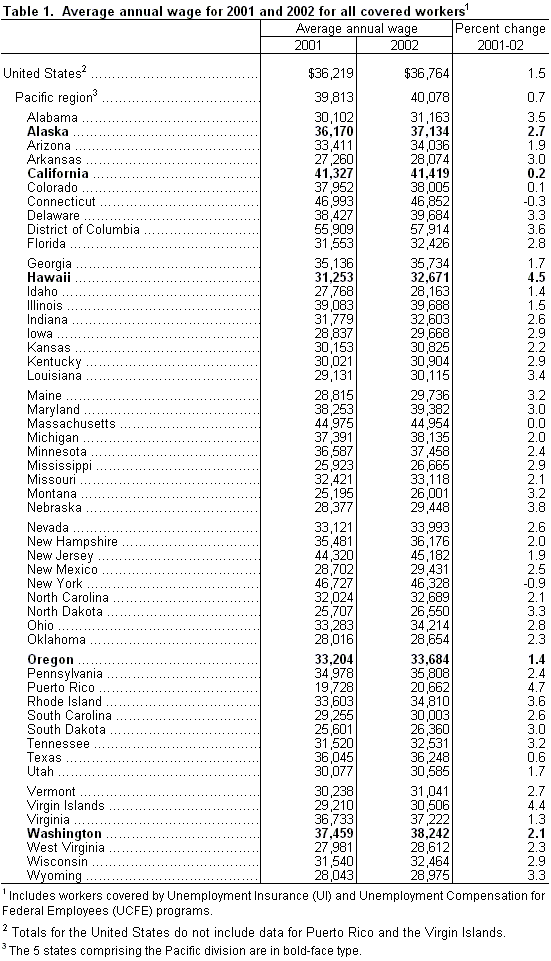 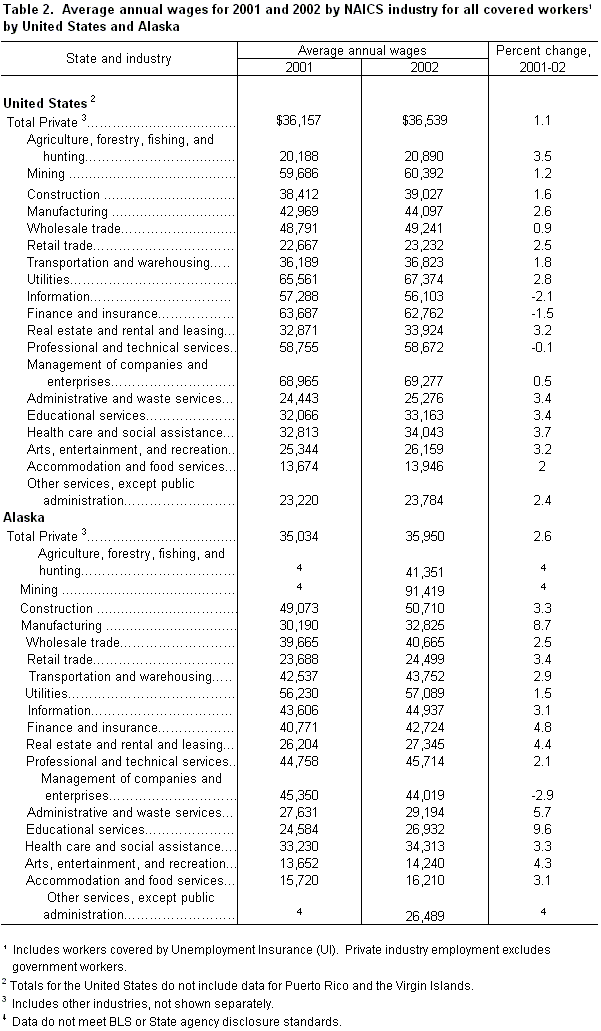 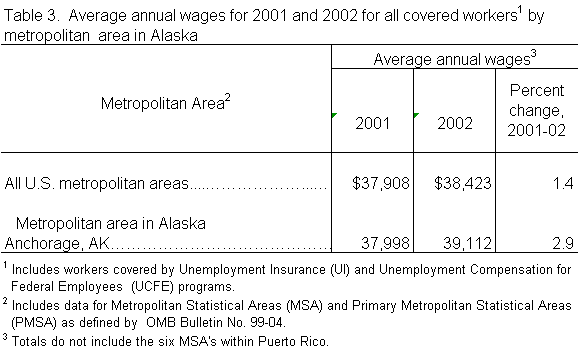 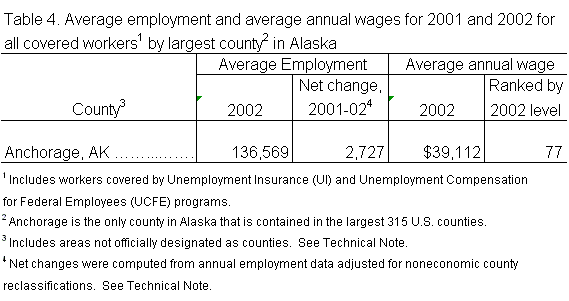
Last Modified Date: August 26, 2004 |
||||
| www.dol.gov |
|
U.S. Bureau of Labor Statistics Western Information Office Attn: EA & I P.O. Box 193766 San Francisco, CA 94119-3766 |
URL: http://www.bls.gov/ro9/ |